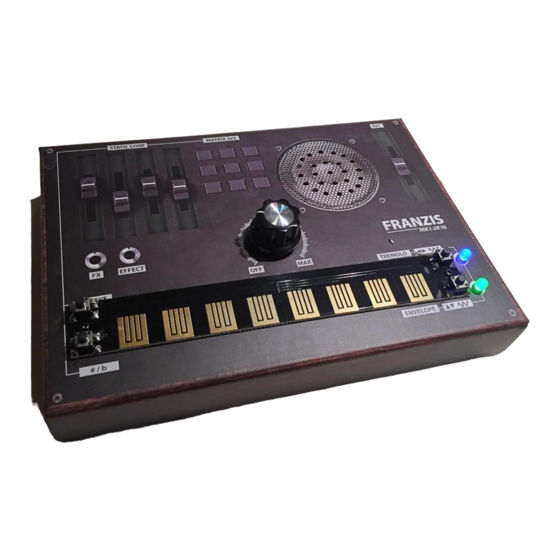
Werbung
Verfügbare Sprachen
Verfügbare Sprachen
Werbung
Inhaltsverzeichnis

Inhaltszusammenfassung für Franzis MKI-2K16
- Seite 1 Synthesizer selber bauen Build your own synthesizer!
- Seite 2 Das Symbol der durchkreuzten Mülltonne bedeutet, dass dieses Produkt getrennt vom Haus- müll als Elektroschrott dem Recycling zugeführt werden muss. Wo Sie die nächst gelegene kostenlose Annahmestelle finden, sagt Ihnen Ihre kommunale Verwaltung. © 2016 Franzis Verlag GmbH, Richard-Reitzner-Allee 2, 85540 Haar ISBN 978-3-645-65341-1 Autor: Dr. Martin Müller Satz: G&U Language &...
- Seite 3 Inhalt Einleitung Wichtige Hinweise Aufbau und Montage Leiterplatte Lautsprecher, Lautstärkeregler und Batteriehalter Bedienung Inbetriebnahme Klangeffekte Funktions beschreibung Prozessor und Schaltung Software Anhang Tipps zur Fehlerbehebung Bauteilliste...
-
Seite 4: Einleitung
Einleitung Mit diesem Synthesizer bauen Sie Ihr eigenes kleines KAPITEL Musikinstrument auf. Spielen Sie Noten im Umfang von zwei Oktaven, natürlich mit allen Halbtönen. Nutzen Sie zu- sätzlich die individuell einstellbaren Soundeffekte Tremolo und Hüllkurvenmodulation, um Ihren Kompositionen oder nachgespielten Musikstücken einen unverwechselbaren lebendigen Klang zu geben. -
Seite 5: Wichtige Hinweise
Abb. 1.1: Kom- Wichtige Hinweise ponenten des Bausatzes Damit der selbst aufgebaute Synthesizer optimal funktioniert, sind einige wenige Details zu beachten. Es ist empfehlenswert, vor dem Zusammenbau die Kapitel 1 und 2 vollständig durchzulesen. Erst dann sollte man den Synthesizer Schritt für Schritt wie beschrieben zusammen- bauen. -
Seite 6: Bauteile Sorgfältig Einlöten
Leiterplatte wackelfrei montieren Die Leiterplatte muss so im Gehäuse befestigt wer- den, dass sie sich beim Betrieb nicht bewegen kann. Hier- für werden zwei kleine Schrauben mit Muttern verwendet. Entsprechende Löcher sind in der Leiterplatte und der Pappschachtel vorhanden. Die beiden Leuchtdioden (LEDs) können (wenn notwendig) mit ein paar Tropfen Alleskleber im Klappdeckel eingeklebt werden. -
Seite 7: Aufbau Und Montage
Aufbau und Montage Im Folgenden werden die beigelegten Bauteile des KAPITEL Synthesizers vorgestellt und ihr Einbau in das Gehäuse wird beschrieben. Leiterplatte Das Herzstück des Synthesizers ist die mit SMD-Bau- teilen bestückte Platine. An sie werden alle anderen elekt- ronischen Komponenten angeschlossen. Lautstärkeregler mit Schalter, Lautsprecher und Batteriehalter werden über Abb. - Seite 8 Synthesizer gerichtet sind. Die Leiterplatte wird mit den beiden mitge- lieferten Schrauben und Muttern befestigt. Man kann die Muttern zusätzlich mit einem Tropfen Alleskleber sichern. Als Nächstes werden die vier Taster auf die Platine Abb. 2.2: Platine gelötet. Die Taster sind die einzigen Komponenten, die auf auf Deckel die nicht mit SMD-Bauteilen bestückte Seite der Leiterplat- (Touchkeys)
- Seite 9 2 Aufbau und Montage Abb. 2.3: Taster auf Platine Nun werden die LEDs angelötet. Die blaue LED wird in das zur Schachtelmitte gelegene Loch geschoben, die grüne LED in das mehr am Rand befindliche Loch gedrückt. Achten Sie auf die richtige Polarität der LEDs. Der länge- re Anschlussdraht der LED (Anode) muss mit dem mit + gekennzeichneten Lötpad, der kürzere (Kathode) mit dem mit - gekennzeichneten Lötpad verbunden werden.
- Seite 10 Waste electrical products should not be disposed of with household waste. Please recycle where facilities exist. Check with your local authority or retailer for recycling advice. © 2016 Franzis Verlag GmbH, Richard-Reitzner-Allee 2, 85540 Haar ISBN 978-3-645-65341-1 Author: Dr. Martin Müller Translation and DTP: G&U Language &...
- Seite 11 Contents Introduction Important note Layout and installation Circuit board Loudspeaker, volume control and battery box Operation Start Sound effects Theory of operation Processor and circuit Software Appendix Troubleshooting Component list...
- Seite 12 Introduction With this synthesizer kit, you can build your own little CHAPTER musical instrument. You can play notes over two octaves, of course including halftones. Additionally, you can use the customizable sound effects, tremolo and envelope modu- lation, to give your compositions or interpretations a unique and lively sound.
- Seite 13 Figure 1.1: Important note Components of the kit You have to observe a few special instructions for your self-assembled synthesizer to work properly. It is recom- mended that you first read chapter 1 and 2 completely and then start to assemble the synthesizer step by step as in- structed.
- Seite 14 Mount the circuit board firmly The circuit board has to be built into the casing in such a way that it cannot move during operation. To this end, two small screws with nuts are used. Matching holes are present in the circuit board and the cardboard housing. If necessary, you can glue the two LEDs to the cardboard lid with a few drops of all-purpose glue.
-
Seite 15: Circuit Board
Layout and installation The following sections describe the components of CHAPTER the synthesizer and explain how to mount them inside the casing. Circuit board The heart of the synthesizer is the circuit board pre-assembled with SMD components. All other electron- ic components are attached to it. - Seite 16 Synthesizer First, screw the circuit board to the lid of the cardboard box. It has to be mounted in such a way that the touch keys are aligned along the rim of the box. Fix the circuit board with the screws and nuts included in the kit. You can secure the nuts additionally by a drop of all-purpose glue.
- Seite 17 2 Layout and installation Figure 2.3: Push-buttons on the circuit board Next, solder the LEDs. Push the blue LED into the hole near the middle of the cardboard box and the green one into the hole near the edge. Make sure of the correct polarity of the LEDs! The longer LED lead (anode) has to be connected to the soldering pad marked “+”, the shorter one (cathode) to the soldering pad marked “-”.